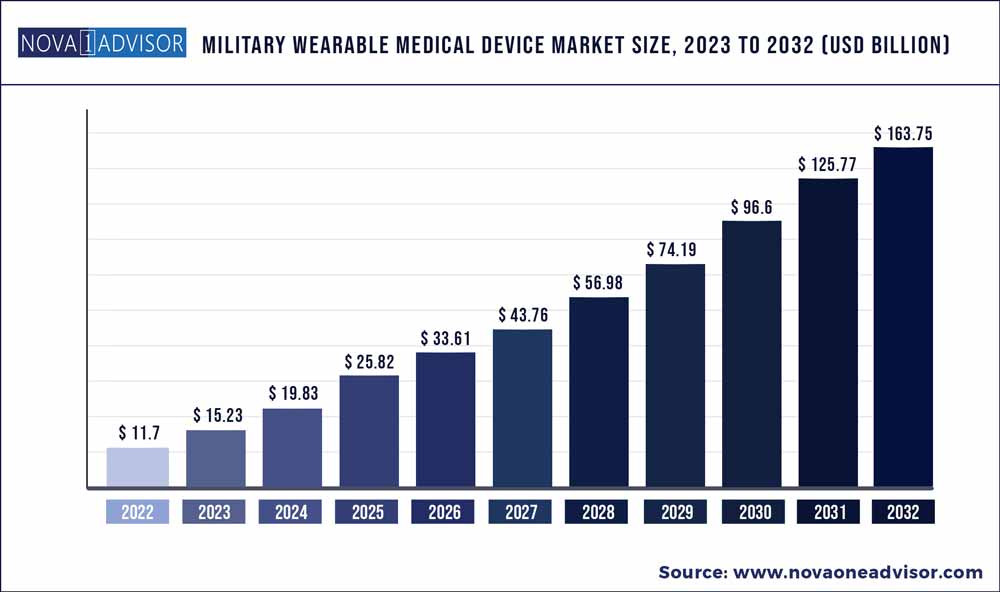The global military wearable medical device market size was exhibited at USD 11.7 billion in 2022 and is projected to hit around USD 163.75 billion by 2032, growing at a CAGR of 30.2% during the forecast period 2023 to 2032.

Key Pointers:
- Heart monitor accounted for the largest revenue share of over 82.19% in 2022.
- North America led the market and held a revenue share of over 37.9% in 2022
- Asia Pacific is expected to witness the fastest growth over the forecast period due to the rising cardiovascular events in the region and rising healthcare spending
- The industry is highly competitive with players who are developing advanced medical devices for the soldiers that can be used in war zones or in extreme environments
Military Wearable Medical Device Market Report Scope
The growth of the market is attributed to the improvement in the overall performance of military soldiers with the help of innovative technology and the rising demand for lightweight military devices.
The Covid-19 pandemic has transformed the market for military wearable medical devices because wearable technologies could monitor, detect, and prevent the spread of the virus. The Covid-19 virus has indirectly increased the demand for wearable medical devices. According to the WHO guidelines, viral infection mainly spreads through the eyes, nose, and mouth and it is difficult to identify the virus during the initial days of contract. Hence, with the innovative technology, the individual can regularly check and monitor their body temperature, oxygen level, heart rate, and body performance so that if they found any negative result, then they can immediately take precautions and treatment.
As soldiers have to train and work in a rough and harsh environment, the wearable device they are carrying must be lightweight and must provide full information of the soldier’s health and performance. Many market players are developing and introducing such wearable devices, which can bear the toughest environment of the battlefield. With the help of the device, armed forces can track and monitor the sleep of every individual, circadian stability, and all physical activity so that they can make necessary changes for better results as per the data.
As per the soldier modernization program, the military has decided to opt for lightweight wearable devices as soldiers already have to carry heavy stuff with them and such devices can increase the speed of the movement. The devices should be easy to carry and made of the toughest material to adapt to the environment. These devices should result in the betterment of the overall performance of the individuals.
The major market players are strengthened by service quality and expertise in proving the advanced technology. There are very few companies manufacturing military wearable medical devices. In September 2022, Garmin International has announced the launch of a new heart rate monitor with the dual transmission. It is a lightweight device that transmits real-time heart rate data. The new product launch is anticipated to increase the revenue of the company.
Some of the prominent players in the Military Wearable Medical Device Market include:
- Bittium
- Polar Electro
- Oura
- Garmin
- NeuroMetrix
- GOQii
- Apple Inc.
- Samsung
- Fitbit
- Zephyr Technology Corporation
- Camntech
Segments Covered in the Report
This report forecasts revenue growth at global, regional, and country levels and provides an analysis of the latest industry trends in each of the sub-segments from 2018 to 2032. For this study, Nova one advisor, Inc. has segmented the global Military Wearable Medical Device market.
By Application
- Heart Monitor
- Sick Alert
- Heart Rate Variability
- Performance monitor
- Sleep-wake Cycle Alert
- Core Body Temperature Monitoring
By Region
- North America
- Europe
- Asia-Pacific
- Latin America
- Middle East & Africa (MEA)

